This is the story of the Adelaide Longbike, a genuine example of innovative design and adaptive technology. It’s the story of people determined to forge their own unique ‘home grown’ lifestyle revolutions. It also illustrates the tantalizing capacity humans have for creative synchronicity around the world! The Longbike story started in the 1970s when a group of like-minded, alternative thinking folk got together to start a community bicycle workshop in an old, inner-city Adelaide suburb – the Musgrave Community Bicycle Works. A small Government grant bought a gas welder and other tools and with the assistance of a generous local resident they set up shop. The Musgrave Workshop is where the Adelaide Longbike was born. But let’s look back a bit further…
From before the turn of the 20th century and well into the 1930s, Australia and Adelaide had a strong bicycle culture, although perhaps few would have thought of it as ‘culture’ at the time. Australians had enthusiastically adopted bicycles as a form of everyday transport from their first appearance in the 1880s and 1890s. Bicycle use had a major social impact on social mobility and access, particularly in regional areas where people often traveled long distances on 2 wheels between outback towns and stations looking for work or social contact. Stories of 200km ‘social visits’ (or romantic trysts) are common! And it appears from the early days that ‘cargo bikes’ were used for everyday transport needs as well. A 1935 catalog from Sampson’s Emporium, Adelaide shows a wide selection of bike models and designs, including several clearly designed for carrying ‘stuff’! These included a ‘front carrier’ delivery model and a bike fitted with a robust sidecar, known as a ‘side van’. Clearly, like so many things in the bike world, the notion of a cargo-carrying bicycle is not new!
So in 2013, with growing world-wide interest in the role a whole new generation of ‘cargo bikes’ might play in improving social resilience and building sustainability, it’s interesting to consider some of the sources of inspiration and design from which the current generation of bikes may have sprung. Given its growing popularity, it’s particularly interesting to consider the origins of what we now know as the ‘long bike’ or ‘long tail’ with its enhanced rear load or people-carrying capacity.
Since the earliest days of bicycle use there have been experiments with bikes with extended wheel bases. Some have used the increased space between axles to provide carrying capacity at the front, often in the form of a box, basket or platform located over a smaller front wheel or on a lowered platform between the handlebars (& steering tube) and the front wheel.
Hence we have the Danish ‘Long John’ and the Dutch ‘Bakfiets’ and a host of other variations influenced by specific cycling cultures, functional needs and market opportunities. Other cargo bikes have used an extended wheel base to provide more carrying capacity behind the rider, and it’s this approach that has grown into what is known as the modern ‘long bike’. Again, there always
seem to have been ‘long bikes’ in the form of ‘people carriers’ – bikes designed to carry a second (and even a third) person as a ‘passenger’ rather than as an additional ‘rider’ (as on a tandem) – such as the Dutch ‘twin-bike’.
However the modern rear cargo carriers are generally described as an entirely new innovation of the last decade or so. Many will for instance be familiar with the very successful Xtracycle Free Radical kit launched in 1998 which allows the bicycle owner to extend a bike’s wheel base rearward about 15″ (375mm) with a number of options available for carrying both people and quite large and heavy items.
The Free Radical’s designs have evolved and now been made available on-line as a technical standard for other manufacturers to copy and use. Thus has been born something of a ‘long bike’ culture, particularly in the USA with the introduction of the popular Surly Big Dummy in 2006 and along with a number of other long tail designs, some of which make use of the Xtracycle cargo-carrying frames and bags.
The growing long bike movement now extends well beyond the Xtracycle with other designs available for those interested in the possibilities of the extended frame. A number of the Western world’s largest bike brands – Trek, Kona and Fisher for instance – have built and marketed their own form of long bikes. The Yuba Mundo which appeared in 2007, now seems set to dominate the market for a while, maybe because it makes maximum use of inexpensive Chinese production, efficient distribution and an effective and evolving design.
So we now have the Xtracycle Free Radical wheelbase extender (1998), spawning the Big Dummy ‘Xtracycle standard’ frame (2006) followed by the Yuba Mundo (2006) plus a number of other longtail designs – mass produced as well as ‘bespoke’, some ‘Xtra-compatible’ and some not. Is this the end of the story? Is this pattern of rear-carrier cargo bike really only a decade or so old? Remember the dictum ‘there is nothing new in cycling’? Well it turns out to be true! The impression often given by advertisements from some of the more recent cargo bike innovators implies they pioneered ‘the original longtail’ some ’15 years ago’. But did the longtail design really come out of the blue?
It’s interesting that following up their Free Radical longtail kit, Xtracycle have now introduced their own ‘long tail’ bicycle – the Edge Runner designed by noted US frame builder, Sam Wittington. This new bike appears to use a travois-style frame as well as a smaller (20″) rear wheel to lower the loaded centre of gravity and to increase rear wheel strength. At the same time Yuba have also introduced their new Boda Boda longtail, the main feature of which (apart from good looks and a relatively light weight) seems to be a reduced and perhaps more practical wheel base.
So there seems to be a design evolution occurring in commercially available longbikes that adds up to a smaller rear wheel, a lower load-carrying rear frame and maybe a slightly shorter ‘long’ wheelbase. It’s great to see this evolution happen but it must be said that these design elements are not new! They all came together in the early 1980s at the Musgrave Street Bike workshop in the design of the Adelaide Longbike after several years of evolutionary thinking and practical experimentation with building cargo and people-carrying bikes. The Adelaide Longbike stemmed from a legacy of innovative and evolutionary bicycle design and experimentation beginning in the late 1970s. So how did it all start?
In 1978, Englishman Ian Grayson, having traveled extensively by bike throughout Asia (including a year cycling around India), was faced with
the very practical problem of getting his daughter to school while maintaining his strongly-held aspiration to lead a car-free lifestyle. Following experiments with child-carrying trailers, Ian had made a couple of ‘child-back’ tandems utilising welded-together ladies bikes and a ‘kiddy crank’ arrangement at the rear. Not finding these particularly satisfactory, he then designed and made an extended frame bike with a relatively low ‘straddle’ basket at the rear. Bruce Steer, a bicycle engineering whizz had observed Ian’s efforts to resolve these every-day transport challenges and was able to help him refine this design to maximise rear ‘basket’ space into what became variously known as the ‘wheelbarrow bike’, ‘Ho Chi Minh’ or (as Ian prefers) the ‘GreenMachine’. The GreenMachines were an exceptionally practical and graceful vehicle and their design remains more-or-less unique right up to today (except perhaps for the UK’s Mike Burrows ‘8Freight’, Vienna’s MSC ‘Truck’ and the USA’s Madsen cargo bike)!
The Musgrave Street workshop was the site for construction of most of these bike design experiments and was perhaps the world’s first ‘long bike factory’! Although only four of the GreenMachine rear-basket bikes were built and supplied to enthusiastic owners, this very limited production was accompanied by the design’s extensive publication in several magazines and newspapers. Ian also conducted an enthusiastic and sustained pre-computer and pre-WWW correspondence with other interested ‘cargo bikers’ and sustainable transport bodies worldwide. More of this later!
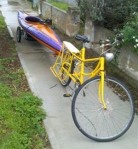
The prototype Longbike, still going, 2016!
Bruce became interested in some of the functional design problems Ian was encountering with the GreenMachine, principally its limitations in carrying older children or very large and flat loads (using a basket rather than a platform) and its long frame’s unwieldiness in some situations. He started to develop his own take on the ‘longtail’ design and over one particularly intense and creative night’s effort at Musgrave Street early in 1988 he put some of his ideas into effect. What emerged was the first Adelaide Longbike, now known as ‘#1’ or ‘The Prototype’, still in use by Bruce today, over 28 years later!
The key aspects of the new design were a more moderate rear extension of the bike’s wheelbase, a smaller 24″ rear wheel, a long rear rack surface above the wheel and strong, permanently attached ‘drop-downs’ with wire side panels and a load-carrying ‘foot’ below the rear axle on each side.
Taking Bruce’s design, Ian went on to custom build 20 more extended bikes (or ‘Longbikes’) as they were labelled and became known. Most Longbikes sported a 24″ rear wheel and a 27″ or 700C front. All featured the rear ‘drop-downs’ and ‘cargo feet’ (or footrests) designed for both load bearing and passengers’ feet, a very strong and stable rear fold-down stand (based on those Ian had seen on roadsters in India and SE Asia) and often a rear passenger ‘steering wheel’. They had a shorter wheelbase than the GreenMachine and were easier live with. They could also carry large, flat or bulky objects on the rear rack that would not fit into the GreenMachine’s basket. The 24″ rear wheel achieved a lowered centre of gravity for the rear load, although when the first mtb craze hit Adelaide at least two experimental Longbikes were also made with 26″ mtb wheels front and rear. Ever conscious of his own design goals, Ian describes these as ‘less successful’. However both are still in frequent use today!
Many of the earlier Longbikes bikes started with conversion of an existing adult bicycle – often an older ‘step through’ or loop-frame bike. After making around 14 this way. Ian sought a more efficient production method. The Longbike’s final iteration – perhaps the last 4 or 5 frames – started with professionally-made and custom-brazed front triangles and frames (one utilising a ‘travois’ frame similar to Xtracycle’s new Edgerunner) from one of Adelaide’s foremost frame builders and are very nice bikes indeed! Nearly all of the Longbikes seem to have had long-reach caliper brakes at the front and rear although some also had cantilevers, depending on what brakes and forks were available.
Most of the Longbikes have held up very well. We know that one or two have been sent to the dump and several are no doubt sitting neglected behind sheds and under verandas. Until recently one was in regular use by Mark Parnell, well known South Australian Greens Member of Parliament (and a great advocate of everyday bicycle use)! Quite a few remain in daily use, often shared across several members of a household,
So where does the Adelaide Longbike stand in relation to other ‘longtail’ designs? It certainly seems to predate the appearance of the ‘longtail’ cargo carrier in the USA (in both bespoke and production forms) by at least a decade. Is the Adelaide Longbike the first recorded cargo-carrying ‘long tail’ and can Ian and Bruce be credited with coining the now widely used term, ‘Longbike’? It’s hard to know of course. This article makes no pretensions at cycling history and nor is there any intention to start an argument about design precedents, ‘who was first’ and so on!
However it is notable that very early in the piece Ian wrote and sent photographs to Jan Vandertuin – now CEO of the Centre for Appropriate Transport and bike company, Human Powered Machines and at the time a major voice in growing US interest in freight bicycles- as well as to several other bicycle authorities and manufacturers in the USA and UK (including Cannondale and Pashley).
In 1992 Jan published a 92 page ‘Workbike Booklet’ which included Ho Chi Minh/GreenMachine photographs sent to him by Ian and the following citation from a reference list provided by the Institute for Transportation and Development Policy in Washington: “The Long Bicycles. By Ian Grayson and Bruce Steer… Two ingenious changes to the basic bicycle. First, picture a tandem bicycle with a basket in lieu of the second seat and you’ll have an idea of Ian Grayson’s creation which can carry huge amounts, from 3 bags of coffee, [Ed; we’re sure he means ‘cement’!] to long poles, to a bevy of partridges. Second, how about an elongated bike, 40cm [Ed; actually 12″] longer than a conventional bike, useful for carrying kids to school or toting plants to a farmer’s market. Instructions and illustrations included.” **
Jan included photos of two of his own rear-carrier bike experiments in this booklet, one apparently inspired by Ian’s GreenMachine! The other seems to have ‘frame-linking’ design elements, later apparently echoed in Xtracycle’s Freeradical bicycle extender.
It’s perhaps worth noting the sequence of distribution and publication that can be pieced together from the Grayson, Steer and Vandertuin archives available to us:
- 1985 (approx): AJG van Bergen publishes a sketch design for a ‘Bush Bike’ to be shown at IFMA and following studies of community transport needs in Tanzania (illustration found in the Grayson/Steer archive). Notable are a slightly longer wheelbase (126cm) and a rear carrier with load-supporting ‘shelves’ or ‘feet’
- 1987: Freewheeling #39, Nov/Dec/Jan 1986-87, a 3-page illustrated article entitled ‘The Ho Chi Minh Bicycle’ written by Ian Grayson explaining the design and origins of his first transport bike.
- 1987: in the Feb, 1987 edition #30 of the APACE National Newsletter for Appropriate Technology & Community Environment, a 3 page article, ‘The Ho Chi Minh – A Sort of Bicycle Ute’, Ian Grayson[‘ute’ is Australian for ‘pickup’].
- 1987: on 19th Feb. 1987, Ian Grayson writes to the editor of Philadelphia’s ‘Network News’, giving permission for the reprinting in that journal of his Freewheeling article on the Ho Chi Minh/GreenMachine, and requesting specific acknowledgment and reference to plans he had made available by mail order.
- 1987: on 9th April, 1987 Ian Grayson writes to Jan Vandertuin (HPV Project) with photos illustrating Bruce Steer-inspired design updates to the GreenMachine. In this letter Ian refers to a previous ‘dossier’ on the HoChoMinh/GreenMachine sent for inclusion in Vandertuin”s ‘data base and further networking’. In a footnote he refers to sending this ‘dossier’ to the Centre for Low Cost Transport in the Netherlands and to the ITDP in Washington. This dossier included a detailed and beautifully illustrated ‘instructable’ giving full details of the Ho Chi Minh’s construction! Ian distributes photocopies of these build instructions widely by post with several versions of the bike reportedly being built. Note – this instructable is still available online (see footnote).
- 1988: Freewheeling #47, Jan/Feb 1988, p 64-66, ‘Long Wheelbase’, a design treatise by Ian Grayson on long wheelbase cargo bike design. In the same edition (p54-57) there was a 4 page article by John Dowlin on ‘Bikes Not Bombs’.
- 1988: in early 1988 the prototype Adelaide Longbike is constructed by Bruce Steer.
- 1988: on Dec. 8th, 1988 Ian Grayson’s development of the extended rear-carrier Longbike appears on the front page of the Adelaide Advertiser with the head-line ‘At Last – a Bicycle Built for Three’ and referring to ‘the Longbike’ by name.
- 1989: The ‘Lore of Cycling’, M Beneke et al, published in Capetown, Jan. 1989. Includes substantial illustrated references to the Ho Chi Minh and the Longbike and mentions Ian by name with a long quote from one of the Freewheeling articles. It reproduces The Advertiser’s front page ‘Longbike’ photo under a heading, ‘The Future’ with the description “a utilitarian but efficient long wheelbase bike designed to be manoeuvrable and stable when carrying loads”.
- 1989: PushOn magazine, Feb/March 1989, p60-63, ‘The L-o-n-g Bike, An Experiment in Utility Design’, Ian Grayson’s treatise on the Adelaide Longbike ‘longtail’ design.
- 1992: Jan Vandertuin’s ‘Work bike booklet No. 1’, illustrates prototype ‘long tail’ designs from a Swiss designer and contains a citation (in an ITDP booklist) which describes the ‘Long Bicycles’ built by Ian Grayson and Bruce Steer, using the term to collectively refer to both the Ho Chi Minh/GreenMachine and the Adelaide Longbike. In this booklet Jan publishes two uncaptioned illustrations of the GreenMachine as well as pictures of two rear-basket carrier bicycles he built himself (possibly inspired by the information and pictures received from Ian Grayson)
- 1996: the UK’s internationally distributed Bike Culture Quarterly published photos and descriptions of first the Ho Chi Minh (issue #10) and then the Adelaide Long Bike (#11), in the latter article specifically using theAdvertiser’s front page illustration and the term, the ‘Longbike’ several times’. Note that this was in 1996 – well before the Xtracycle and the current extended frame cargo bikes appeared.
- 1998: the Xtracycle Free Radical kit is first released.
- 2006: Surly releases the Big Dummy longbike utilising the Xtracycle accessory kit.
The extent to which the Network News reprint of Ian’s Freewheeling article (in about 1987) and the ‘Long Bicycles’ reference in Jan Vandertuin’s booklet (1992) were distributed in the USA or elsewhere is not clear. It’s believed however that the photo and small article article in issue 11 (Dec. 1996) of BCQ represents the first published use of the term ‘Longbike’ in a larger-scale international publication, used with reference to a specific design theme as well as to a specific bike.
It’s worth noting that at the time of this international publication in 1996, the first GreenMachine was nearly 20 years old and the first Adelaide Longbike 8 years old, with the first Australian press recognition having also been nearly a decade earlier! At the time, Bruce and Ian were very interested in finding a manufacturer for their machine and it’s interesting to speculate on the outcomes of their work if it had coincided with the more recent growth in global communications and networked design and manufacturing.
Four Ho Chi Minh ‘wheelbarrow’ bikes and around 20-22 hand-made Adelaide Longbikes were delivered to happy customers. We are currently trying to ascertain how many of each are left and ensure more is understood about the innovative roles that Bruce and Ian, and indeed the owners (or ‘custodians’) of Adelaide Long Bikes played in the development of Adelaide’s bicycle culture as we know it today. If you know of one of these bikes languishing unused somewhere please let us know. If you have one you’d like to get going there is help available!
There’s an extensive ‘Longbike’ flikr page here. If you have photographs you’d like to contribute to this project please contact us. Prints are fine – we’re happy to scan them and return to you. Eventually we may even have a proper Adelaide Long Bike web site. We have also contributed several hours of locally shot video about the ALB to a US cargo-bike film currently in preparation – see (R)Evolutions Per Minute & and the trailer.
If you have an Adelaide Long Bike or would like to contribute to their history or preservation please contact the Port BUG Secretary (Sam). If you know of one languishing somewhere that needs rescuing we have the rescue team ready!
 ** Ian Grayson’s beautifully illustrated 1970’s guide to building the Ho Chi Minh/GreenMachine cargo bike is available at the following link (courtesy of Soft Technology magazine): Build the Ho Chi Minh
** Ian Grayson’s beautifully illustrated 1970’s guide to building the Ho Chi Minh/GreenMachine cargo bike is available at the following link (courtesy of Soft Technology magazine): Build the Ho Chi Minh
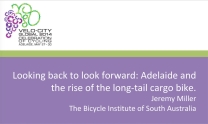 ** In 2014 the international VeloCity Conference was held here in Adelaide. Jeremy Miller – long-time ALB fan – gave a wonderful presentation titled ‘Looking Back to Look Forward: Adelaide & the Rise of the Long-tail Cargo Bike’.
** In 2014 the international VeloCity Conference was held here in Adelaide. Jeremy Miller – long-time ALB fan – gave a wonderful presentation titled ‘Looking Back to Look Forward: Adelaide & the Rise of the Long-tail Cargo Bike’.
Check out a pdf version here: Looking back to Look Forward.



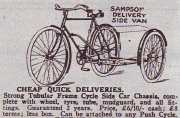
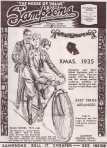

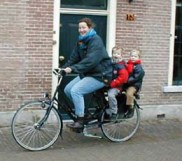

















Fantastic – lovely to think of all those happy long-bikers out there. And Adelaide’s own innovators – stunning!
LikeLike
I remember fondly the Musgrave Street workshop at Goodwood where some of these machines were fashioned in the 80s – as anyone else could come by and fix a seat or a tyre, get great advice and more – all in a shed offered by a lady who was happy to see the building put to good use. Great to see the history of this movement finding it’s place on these pages. Tim Walsh
LikeLike
I love knowing this history! When I traveled through Australia in 2001, I brought one of the first bolt-on Longtail kits that we had made in Taiwan (unfortunately stolen in Byron). I wish that I had known about you guys then. I hope to come back early 2014. Maybe we can all meet up?
Also, you may have seen that Liz released two new videos. This “teaser”: http://lizcanning.com/Liz_Canning_Creative/LESS_CAR_MORE_GO_2013_Update_video.html and the link below that video is to the longer “Birth of an American Cargo Bike”.
My hat is off to you all and Ian in particular for helping make his ideas known. As Liz tells in her story, I saw a 3 pager about the Ho Chi Mihn bike while I was studying vehicle design at CESTA – the appropriate technology center in San Salvador. Later, I was deeply influenced by a Canadian named Randy Parent who was living and working in Managua, Nicaragua – who was designing and building longtail cargo bikes with 20″ wheels. The rest, as they say, is history.
All the best,
Ross Evans (Xtracycle’s Founding Father)
LikeLike
Hi Ross, It’s great to see your comments. Ian Grayson will be pleased to know that his own ideas were of some inspiration to your own amazing efforts and creativity. Ian is still living an essentially car-free and low-tech bike-based lifestyle (I put a new TV together for him recently) but we’ll take a laptop around to his place to play him the latest trailers from Liz’s web site. I am posting off a drive with Longbike stuff on it for Liz’s film today! I would like to develop the Longbike page into something a little more comprehensive and representative of the world-wide creative bike movement of the ’70s and ’80s. If you have any writings or photos of Randy Parent’s creations I’d be very interested to see them and maybe put some up. And if you are visiting Australia in 2014, I and others would be very keen to catch up!
best wishes,
Sam Powrie.
LikeLike
Thanks for great pictures and links. I am a happy user of Xtracycle and these old bikes are really interesting. I found that here in Czech Republic even xtracycle-kit is considered expensive, so useful tutorial for selfbuilders is great! Also remind me old recumben tutorial for original Easy Racer. Love these ancient publications made by blending typewriter and handsketches together. We like to think that internet is the Originator but there always were zines and people clever behind them. Thanks
LikeLike
Hi Ladia,
Nice to hear from you! I think the thing I learn from this history is that both need and the ability to find creative solutions to problems are a shared enterprise around the world. More than that, there are also lessons in this history of a shared ‘synchronicity’ in human activity all around the world that is there whether we have the internet or not! We just have to believe in it and do it!
Sam.
LikeLike
Just came upon your site. Glad to finally know at last that I was not hallucinating when in 1985 I got to Mangrove Mountain north of Sydney and I saw a longbike parked up outside a store. It was like Jan Vandertuin’s rear basket/platform. I had just ridden up from Wiseman’s Ferry and was very thirsty (going from Canberra to Brisbane). When I got back outside I meant to have a look at it but a young bloke had just loaded it up with supplies and was taking off the other way . I yelled after him, but he wouldn’t stop. All he said was ‘Ho Chi Minh!’ I have been fascinated by workbikes ever since because I couldn’t get the idea of it out of my head.
I live in London now but got an Xtrabike kit when I was in San Francisco in 2004 and am still using it for hauling people, shopping etc. That original xtracycle steel frame was bomb proof as it got rear ended by a truck a few years ago and bent to hell with the rear part of the cantilever finally cracking off 2 years later even though I managed to bend it back roughly as per the original. I propped it up with a regular bike rack and she still goes strong though not as forgiving over the bumps – 12 years and countless kg miles.
Great ideas like this can never die and I look forward to the next couple of decades of evolution.
Giles
LikeLike
Hi Giles,
Great to hear from you over in the UK. It’s very interesting to hear how such a fleeting experience of something entirely new can have such an impact on one’s outlook and imagination. Several people have made comments such as yours about their first – often momentary – observation of Ian and Bruce’s original ‘Longbikes’. Jeremy Miller here in Adelaide saw Ian’s parked outside a bike shop a couple of decades ago and found his life set on a new course. I saw a tiny B&W picture of Ian on his Longbike bike in BCQ accompanying a reader’s letter many years ago and was blown away too! AFAIK only 4 Ho Chi Minh’s (or ‘Green Machines’ as I believe Ian prefers to call them) were made. And it seems only one now survives although another may still be kicking around South of Adelaide somewhere. But it’s the idea that’s important isn’t it! As you say, ‘great ideas like this can never die…’
Sam – Ed.
LikeLike
Further to the comment above from Giles – I suspect that the GreenMachine that he saw near Wiseman’s Ferry may have been one of two that a couple of young women from Adelaide took interstate back in the ’80s when they did a ‘festival tour’. I had thought that they went to one of Jim Cairn’s ‘ConFest’ gatherings but they may have also (or alternatively) attended one of the Woodford or related ‘alterno’ festivals that were springing up in Northern NSW. There are a few B&W pics in the slide show above of loaded-up GreenMachine’s that illustrate their departure on this festival expedition. All from Ian Grayson’s fantastic documentary archive!
Sam – Ed.
LikeLike
FYI, the links in the article are all 404 :
https://portadbug.org/the-adelaide-long-bike-the-resurgence-of-bike-culture-in-the-1970s/lb-bs-22-e/#main
https://portadbug.org/the-adelaide-long-bike-the-resurgence-of-bike-culture-in-the-1970s/lb-bs-17-e/#main
https://portadbug.org/about/mark-parnell-longbike-3/#main
etc.
LikeLike
Thanks Andy, something’s obviously awry! I’ll chase it up!
LikeLike